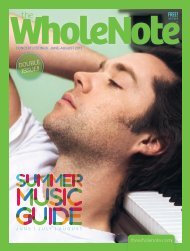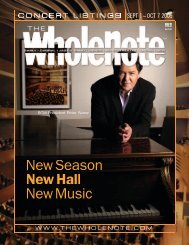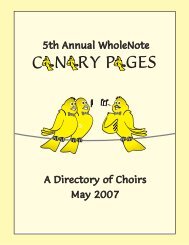CONVERSATIONS at THE WHOLENOTEComposerLeap Frog withAustin Clarkson✒ David PerlmanAt some point in my recent conversationwith musicologist Austin Clarksonhe used the phrase “leapfrogging seriesof interactions” to describe the relationshipsamong four composers,Anton Webern,Stefan Wolpe, MortonFeldman andJohn Cage.“Stefan meetsAnton and Mortymeets John” is thetitle of an October 6concert and accompanyingseminar,both curated byClarkson, to launchthe 43rd season ofNew Music Concertswith whom Clarksonhas had a relationshipspanningmore than two and ahalf decades. Whilethe four composersin question never allmet, the intersections of their lives and workmake for an interesting daisy chain of musicalthought and circumstance.Clarkson explains: “Cage had met MortonFeldman at a concert in Carnegie Hall conductedby Dmitri Mitropoulos with the NewYork Philharmonic playing the Webern SymphonyOp.21. <strong>The</strong>y both left the concert at thesame time and Morty went up to John and said,‘Wasn’t that beautiful.’ Because he [Feldman]had already seen John Cage at a meeting atone of the musicales at the Wolpe apartmentuptown, and had not spoken to him. But thistime he spoke to him.”<strong>The</strong> date of this concert was January 26, 1950,and it was, by several accounts, a memorableoccasion. Music writer Alex Ross, for one, inhis book <strong>The</strong> Rest Is Noise asserts that the twoleft the concert early, equally disgusted at thereaction of the New York Phil audience to theWebern piece.“Sounds as if it was in that mandatory ‘beforethe intermission’ slot for new music” I posit toClarkson, and he briefly nods assent to thenotion before carrying on with his story:“So Feldman at that time was writing a stringquartet also, which he came to call Structures,Clarkson with <strong>The</strong> WholeNote editor Perlman.“I had written my thesis onStravinsky’s Symphony inThree Movements —but Wolpe was beyond that”and he by that time had left the Wolpe studio— he wasn’t taking lessons anymore — andhe was kind of trying to find his own way,very much involved with the New York painters.And so Cageinvited him to hisapartment down onthe East River, andMorty showed himthis draft of thisstring quartet. AndCage said, ‘Well howdid you make that?’He was fascinated.And Morty said, ‘Idon’t know.’”Leapfrog, indeed,among the composers;even more interesting,as it emergesduring the conversation,is the way inwhich Clarkson’sown musical life hasbeen inextricablyinterwoven with thelives of his musical subjects, above all Wolpe.“When did you discover [Wolpe’s]work?” I ask.“Well, I discovered his work in Sam’s recordshop when it was on College St., west ofBathurst. And it was 1957 or ’6 when I wasworking in Saskatchewan at the University ofSaskatchewan in Saskatoon (my first job aftergraduating from Eastman). And I was thumbingthrough the new releases and I picked upthis LP and saw the face of this composer inmany different angles and moods, from laughingto looking very pensive, and he had an openshirt, and he was so out there. And I thoughtthis must be interesting, so I turned it over,and there Aaron Copland had a blurb sayingthat Wolpe was one of the most importantcomposers of this era. So I thought well I’lltry this and I took it home and played it. And Ithought it was absolutely ... bizarre. I could notunderstand it. I had gotten as far as Bartók andStravinsky — I had written my thesis on Stravinsky’sSymphony in Three Movements — butWolpe was beyond that. And when I played itfor my friends they thought this is absolutelyridiculous. So then I get to New York and I’mstudying for my doctorate at Columbia, andmy roommate who was a pianist studying andteaching at Juilliard said would I like to join asmall group of students who are studying withthis composer who needs money because heis very poor, and my girlfriend is a student ofhis wife’s. And I said what’s his name? And hesaid, Stefan Wolpe.”“When I first went into his room, his thirdfloor walk-up, on West 70th St., it was likewalking into a seismic event,” Clarkson says.“This man radiated the kind of energy that youdidn’t believe people could provide — just likean everyday thing. Also he revealed that musicwas beyond something I had ever experiencedup until that point. And I realized that it wasgoing to be really a life’s work to becomeadequate to this way of being in music. Sothat’s where it began.”Wolpe died in 1972 ofParkinson’s, and, asClarkson explains it,“So I finished myPh.D. ... and I wasthe only musicologistreally inhis circle. <strong>The</strong>rewas one other butshe was a really terrificpianist and she wasdevoted to that career, although she did a greatdeal. So it turned out that I had to become aWolpe specialist. <strong>The</strong>re didn’t seem to be anyoneelse to do it.”Wolpe’s pivotal role in this game of composerleapfrog becomes more clear asClarkson describes the program for theOctober 6 concert.“<strong>The</strong> first piece I chose was a Concerto forNine Instruments that Wolpe wrote while hewas studying with Webern ... in Vienna,” Clarksonexplains. “He’d arrived in Vienna as a refugeefrom Nazi Berlin, just in September of 1933,and he had three months with Webern beforethe Austrian police expelled him from Austriawith the threat to deport him back to Germany.And so in those three months he composed thisconcerto for nine instruments. And at the sametime, curiously, Webern was composing hisown concerto which turned out to be for nineinstruments eventually. So there are those twokey pieces, the Wolpe concerto and the Webernconcerto, both for nine instruments, almostexactly the same instruments.”“And then the next piece chronologically isJohn Cage’s String Quartet, and it’s a piece hewrote beginning in Paris when he was thereon a fellowship to study at the BibliothèqueNationale the music of Satie, but while he wasthere he met Boulez and he went to the studioof Messiaen and played his Sonatas and Interludesand began his string quartet. And he finishedit the next year in 1950.”It’s from “a whole period of classical Cage,”Clarkson says, “that people don’t know muchabout. Because after he turned to indeterminacyhe became the Cage we all knowtoday ... <strong>The</strong> string quartet is a masterpiece. It’sa classic. And yet we don’t hear it very muchbecause it’s the other Cage that we know moreabout, that we hear more about.”12 | September 1 – October 7, 2013 thewholenote.comCage.
<strong>The</strong> next piece on the program is Feldman’sStructures. Clarkson, for one, doesn’t buy Feldman’scomment to Cage that he (Feldman)“didn’t know” how he made the piece. “In factI brought it if you want to see it,” Clarkson says.“Actually Morty knew pretty much what he wascomposing, because I have analyzed it and I cansee how he was adapting Wolpe’s way of workingwith shapes for his own imagination. Sothen ... Feldman really became a member of theCage circle, but he said Wolpe was totally okaywith that.”It was by no means a “given” that Wolpewould have been comfortable with Feldmanbecoming part of Cage’s circle. “Cage andWolpe — they had real arguments, in public,”Clarkson explains. “<strong>The</strong>y were famous fortheir shouting matches and they happened onthe streets of New York, and conferences, andDarmstadt, and it was ... yeah. But the argumentwas never over whether music was purethought in itself. For Cage, it had to be a pieceof ... the nature out there, which is exactly whatWebern said. ‘Art is an expression of nature, butas seen through human nature.’ ... To that extentthey both agreed, Cageand Wolpe. It’s justthat they had differentnatures. AndFeldman.so their musiccame out totallydifferently.”And so it wasthat Feldmanmoved into Cage’scircle without acrimonyfrom Wolpe. “He [Wolpe] was totally open, hedidn’t feel aggrieved or somehow that Feldmanhad let him down, so Feldman then workedwith Cage ... not worked with him, but kindof was in his circle with the artists and goingto the artist’s club downtown on 8th St. anddeveloping his unique imagination in a waythat Wolpe hadn’t yet been able to support. Andthe curious thing is that in the later 50s, Wolpecame to see the virtue of the kind of music thatFeldman was writing, and developed his ownnotion of what he called the ‘discontinuum.’And so the final piece on the program is goingto be this Wolpe piece for chamber orchestra,Chamber Piece No.1, in Wolpe’s late style,which is like moment form, each moment iskind of unto itself.”<strong>The</strong> work is from a period in Wolpe’s life,post-war Germany at Darmstadt in the summer,where Wolpe, according to Clarkson, wasable to close some important circles: “He founda new life,” Clarkson says. “Because he broughtAmerican expressionism [back to Europe], andthere he found Webernian structuralism, andhe returned to Webern in a way that he hadn’tbeen connected for 20 years — it was a marvellousrediscovery for him. And in fact this piece,the Chamber Piece No.1 that you will hear onthe concert, is an homageto Webern. And ituses the same pitchset from Webern’sConcertoand it starts withthe same forminterval that thethird movement ofthe concerto beginswith. And then later inWebern.the score, he’s written ‘Oh, ... Webern!’ on themanuscript. So it is really very touching tosee that the journey is now somehow closedand that he’s come to a new understandingof Webern where he can put Webern into thismoment-form environment and still have himlive and breathe.”One senses that the October 6 concert closessome circles for Clarkson too. “Exactly 20years ago, we did a four-day festival of Wolpe’smusic,” he says, “where we had symposiums,seminars, concerts, workshops; we had a galleryof marvellous performers, Peter Serkincame up, we had performers coming from allover. And out of that we produced a book andthere were recordings so it was a major event.But since then, not so much.”For a musical generalist like me, theOctober 6 concert promises to be a journeythrough a lot of unfamiliar territory, somewhatakin, perhaps, to Clarkson’s own first encounterwith Wolpe’s music back in 1956 at Sam’son College St. But there’s considerable comfortin now having a clearer sense of the individualbehind the concert’s curatorial steeringwheel. “I knew Morton Feldman very well,”says Clarkson, “and John Cage I knew also. Hewould often visit York University where I taughtfor 25 years. And David Tudor, also, who wasthe pianist who actually was like the linchpinbetween the Cage and Wolpe groups, becausehe played all their music.”“It’s very interesting: what Feldman says isof most importance to him (and this is a wayto prepare for this concert) is listening. He’sconcerned only [with] what happens whenyou listen. And that there is a different kindof listening that happens in different kindsof music. And his kind of music demands themost extreme listening because he maybe hasa sound here, and then nothing for a while,and then another sound, and you have to figureout, well, what’s happeninghere? What’sin between? So Wolpe.that listening toa Feldman pieceis a totally differentexperiencethan listening toa Wolpe piece. Butif you play Feldmanvery fast, and Wolpe veryslow, actually you’ll hear a connection.”You can link to Austin Clarkson’srecommended recordings of theworks referenced in this article byreading the story on our website;and you can also view a video ofthis entire conversation, or listen to apodcast of it, by visiting our website:thewholenote.com.thewholenote.com September 1 – October 7, 2013 | 13
















